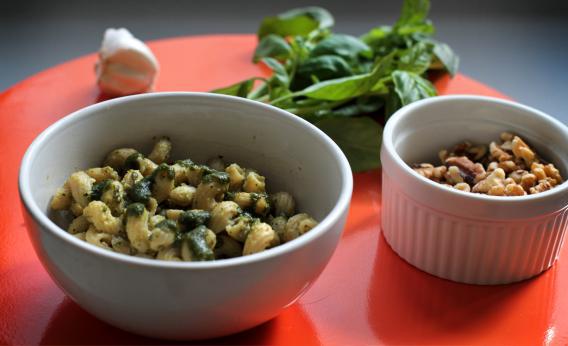Pasta, pesto (and its French cousin pistou), and paste all come from the same Latin root.* You may notice that one of these things is not like the others: Paste is not a word with delicious connotations. And yet the etymological kinship makes sense: pasta dough is pretty much a paste of water and flour (and sometimes egg), while pesto is a paste of basil, traditionally made in a mortar and pestle (another descendent of the Latin pasta).
Though pasta is more central to most of our diets and pesto is associated in certain snooty minds with ’80s-era fondness for now-passé Italian dishes (tiramisu, anyone?), it’s fairly indisputable that pesto wins the edible paste contest hands down. It’s flat-out brilliant. The only way to get more of that heady aroma out of fresh basil is to smash it, and the only way to improve on that aroma is to add luxurious ingredients with a fattiness that will intensify the herbal essence: olive oil, Parmesan cheese, and pine nuts. (Garlic doesn’t hurt, either. Garlic never hurts.)
The problem with homemade pesto is the tendency many people have to focus on the basil at the exclusion of the other ingredients. If you want a truly exceptional sauce, and not merely a suspension of herb flecks in olive oil, you must not be shy about adding plenty of cheese and nuts—and you need not be strict about hewing precisely to tradition. Parmigiano Reggiano is the classic in pesto Genovese, but a decent pecorino Romano makes a respectable substitute without doing quite as much damage to your bank statement. Likewise, walnuts have a crunchy-yet-waxy texture similar to that of pine nuts, and they can cost half as much as pine nuts by weight. The difference between the upscale version and the affordable doppelgänger is akin to that between a vinyl edition of the Rolling Stones’ Sticky Fingers and a download of its tracks. They both sound pretty damn good.
It goes without saying that you can put pesto on pretty much anything: sandwiches, vegetables, meats, fish. But my favorite way of serving it is the Ligurian way: with both pasta and potatoes. (Traditional pasta alla ligure includes green beans, too, so throw a few handfuls into your pot of boiling water a few minutes before draining the pasta and potatoes, if you like. Broccoli and asparagus are nice verdant additions, too.) There’s something ridiculously indulgent about eating pasta and potatoes together in the same dish, and the soft edges of the boiled potatoes blur into the pesto to create a sauce that’s even creamier and richer than pesto by itself.
Update, Sept. 27, 2012: Friend of Slate and Oxford English Dictionary editor-at-large Jesse Sheidlower alerts me that these words are not as related as they look. Sheidlower writes, “[P]esto and pistu are related to each other, as are pasta and paste, but they’re from completly different Latin roots. Pesto is ultimately from Latin pīnsere, ”to pound,’ while pasta and paste are from Latin pasta, itself from a Greek word meaning ‘barley porridge,’ from a verb meaning ‘to sprinkle.’” Pestle is also related to pīnsere. So while pesto and pasta dough are both related to paste in spirit, only one is related etymologically.
Pasta With Pesto and Potatoes
Yield: 6 servings
Time: 25 minutes
½ cup pine nuts or walnuts
Salt
1 pound waxy potatoes, peeled and cut into ½-inch chunks
1 pound penne, cavatappi, or other cut pasta
Leaves from 1 medium bunch fresh basil
⅔ cup extra-virgin olive oil
½ cup grated Parmesan or pecorino Romano cheese, plus more for serving
3 garlic cloves
1. Bring a large pot of water to a boil. Meanwhile, put the nuts in a large skillet over medium heat and toast, shaking the pan occasionally, until fragrant and lightly browned, about 5 minutes.
2. When the water comes to a boil, salt it generously and add the potatoes. The potatoes should cook for 15 minutes total, so add the pasta to the water about 5 to 10 minutes later, depending on the package instructions, so the potatoes and pasta finish cooking at the same time. While the potatoes and pasta cook, put the basil, olive oil, nuts, cheese, garlic, and a large pinch of salt in a food processor or blender and process until smooth.
3. When the potatoes are fully tender and the pasta is al dente, scoop about a cup of their cooking liquid out of the pot, and then drain the potatoes and pasta. Toss the potatoes and pasta with the pesto, adding the reserved cooking liquid as needed to thin out the sauce. Taste and adjust the seasoning, and serve immediately, topped with additional grated Parmesan or pecorino Romano, if desired.
Previously in You’re Doing It Wrong:
Lentils
Pumpkin Bread
Grilled Cheese
Green Beans
Macaroni and Cheese
Frittata
Pizza
